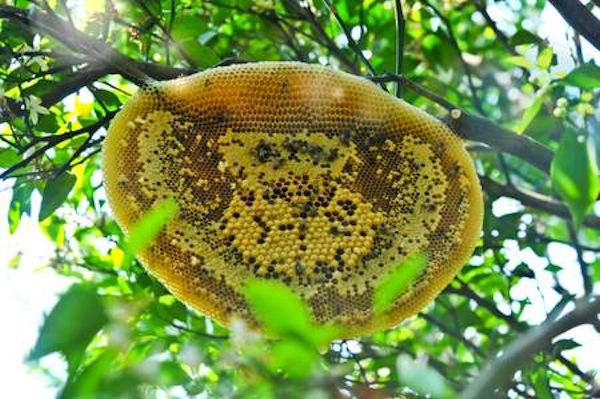Bees, Wasps, and Kin
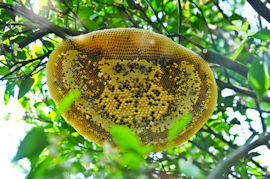 |
Life Cycle of Bees
Apis millifera |
Description
The life of all honeybees starts as an egg, about the size of a comma ","
which is laid by the queen in the bottom of a wax cell in the brood area of
a hive.
A worker egg hatches after 3 days into a larva. Nurse bees feed it
royal jelly at first, then pollen & honey for 6 days.It then becomes an
inactive pupa.
The honey comb has hexagon cells on both sides of a vertical central wall.
As shown in the photo, these cells are inclined upward, primarily to
retain liquid nectar and honey.
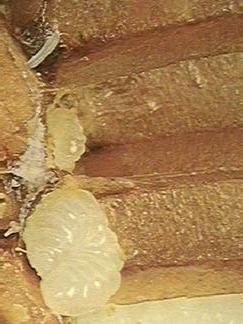 |
Male bees are called drones.
They emerge in 24 days, larger than the female
workers. They have large eyes and no stinger. They lead a life of leisure,
doing no work while being fed by the workers. Their sole purpose is to mate
with a queen from any hive, thereby transfering the genetic traits of their
mother. They die upon mating, or are expelled from the hive as winter
approaches. |
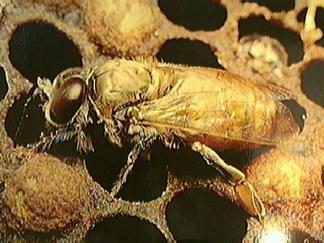 |
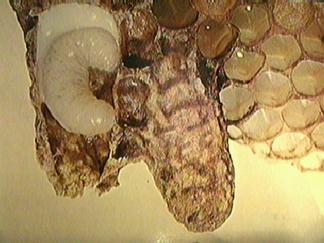 |
Before an old queen dies, or departs to start another hive, she lays an egg
in a large queen cell. The nurse bees feed the larva a diet of only royal
jelley, or bee's milk, made from a gland on their heads. In only 16 days a
new queen emerges. She seeks out and destroys any rival queens, because
there can be only one queen per colony. |
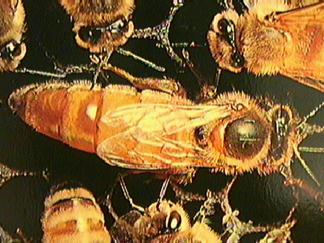 |
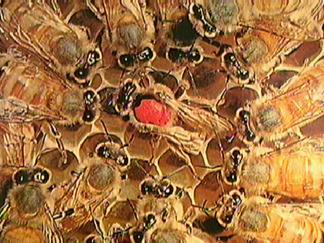 |
When 10 days old, a new queen takes a high maiden flight, pursued by drones
from nearby hives. In about 13 minutes, she mates with 7 or more of them,
storing their sperm for the rest of her life of 2 years.
She produces chemical scents which regulate hive activity.
The queen lays about 1200 eggs per day, about 200,000 per season. This is
necessary since worker bees only live 6 weeks in the summertime; and a
colony needs to have 40 to 50 thousand bees at its peak. She is cared for
by the worker bees. The queen shown on the left has been marked with a red dot for easy
identification. |
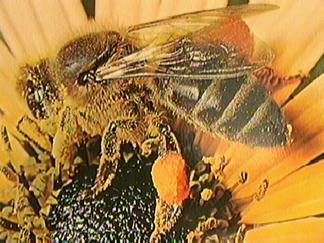 |
Worker bees gather pollen which they stick to their back legs, to carry back
to the hive where it is used as food. Pollen from the stamens of one flower,
stick to their bodies, and is carried to another flower where it rubs off
onto the pistil, resulting in cross pollination. Mankind's food supply depends
greatly on crop pollination by honeybees. Nectar is sucked up through the proboscis, mixed with enzymes in the stomach,
and carried back to the hive, where it is stored in wax cells and evaporated
into honey.
Worker bees must maintain the hive's brood chamber at 94 degrees F to
incubate the eggs. If it is too hot, they collect water and deposit it
around the hive, then fan air through with their wings causing cooling by
evaporation. If it is too cold, they cluster together to generate body heat.
Propolis, or tree resin, is used to seal any openings in the hive against
drafts or invaders. |
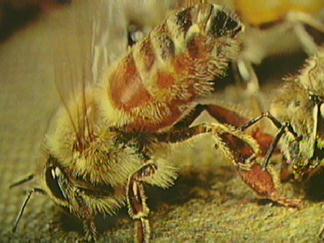 |









